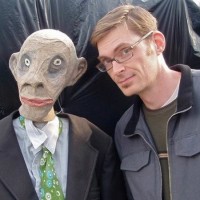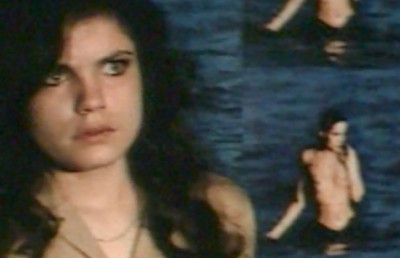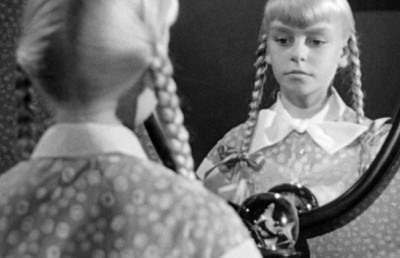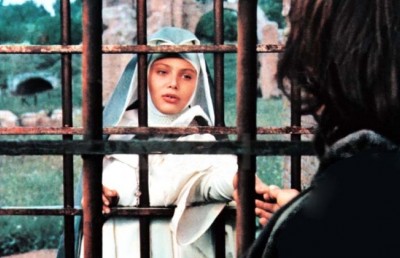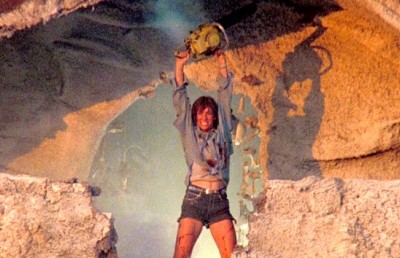Race, Sexuality, and Procreation in H.P. Lovecraft Film Adaptations
Fish People in the Family Tree
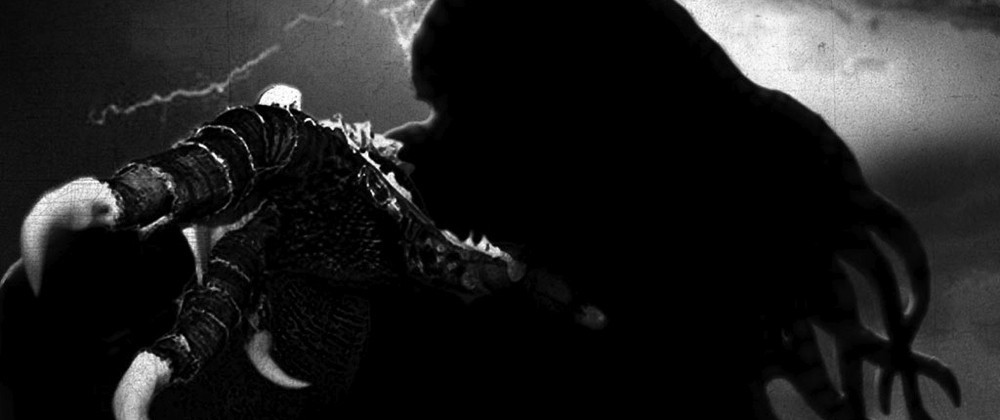
Despite a cult following that has grown steadily over the course of decades, feature film adaptations of the horror fiction of H.P. Lovecraft remain relatively few. 1 In part this is because his work’s cosmic scope and pervasive sense of doom and decay are notoriously resistant to successful screen adaptations, and the colossal, amorphous deities of his mythos defy the small budgets of the independent production companies that have been more disposed to attempt film versions. In part, too, the nativism and xenophobia the prim, bigoted Lovecraft espoused in life and allegorized in his fiction through themes of interspecies breeding and its resultant atavism have tainted his work and his reputation with an air of racism far more objectionable than any of his macabre, nihilistic narratives.
Just as a handful of small production companies have found inventive ways around issues of budget, scale, and the depiction of “indescribable” monsters, a number of filmmakers have devised ways of linking the dread of the Other, paranoia over miscegenation, and hints of gynophobia in Lovecraft’s work to other issues of gender and sexuality. This essay explores such revisions of Lovecraft’s xenophobic and sex phobic subtexts in film adaptations. I make the case that Lovecraft’s exploitation of early 20th century America’s social anxieties over the threatening racial, ethnic, religious, and sexual difference represented by “undesirable” immigrants has provided recent filmmakers with compelling material to reimagine and recontextualize as a way of commenting upon sex and gender anxieties more resonant with 21st century audiences.
I demonstrate this through a brief overview of what director Guillermo del Toro has referred to as Lovecraft’s “absolutely genuine worry of the evils of mixed breeding — and breeding in general” as conveyed in his fiction. 2 Then I explore how film adaptations have exponentially increased the sexual content of Lovecraft’s narratives, partially for audience-drawing titillation, partially to mark themselves as “modern” or “edgy,” but also partially as a critique of contemporary gender relations, sexual mores, and psychosexual angst. This analysis focuses primarily on the 2007 small-budget independent film Cthulhu , a production unique in its modification of Lovercraftian themes to allegorize the social pressures and perils faced by gay men, using the protagonist’s gayness as a way of addressing compulsory heteronormativity, family relations, religious oppression, and reproductive issues. As an all-too-rare horror film with generally positive representations of gay characters that addresses the concerns of LGBT people, Cthulhu differs from most horror media targeted to gay audiences, which tend towards campy parodies of the genre and/or soft pornography crowded with shirtless beefcake vampires biting shirtless beefcake victims. 3 In this more “serious” approach to fears and anxieties, Cthulhu exemplifies the potential significance of the horror genre for queer communities.
Queer sexuality, which “suggests death over life by focusing on non-procreative sexual behaviors,” is “especially suited” to the horror genre, Harry Benshoff argues, which takes sex and death as “central thematic concerns.” 4 Because Lovecraft regarded sexuality in general as dangerous to both societal and psychological stability, all sex, including and especially procreative sex, is queer in its potential to disrupt and transform. This blurring of “normal” and “abnormal” in Lovecraft’s work and mindset, in which sex, reproduction, and even contact with the opposite sex, are unfamiliar and fearful, in many ways corresponds to queering, the process of defamiliarizing the familiar as a form of analysis and critique. While Lovecraft’s acts of defamiliarization were intended to shore up a rigid status quo by making deviations synonymous with chaos and destruction, the estrangement of sex and procreation in film adaptations of his work more often align the status quo with repression and restrictions that induce rather than suppress turmoil, and with forces of power and authority more malevolent than any supernatural menace.
The Sexual Threat in Lovecraft’s Fiction
In his book-length essay on Lovecraft, Michel Houellebecq remarks on the author’s idée fixe that “Evil is the product of a carnal union against nature,” writing that this notion “fits his obsessive racism perfectly; for, to him, as to all racists, it is not one particular race that represents true horror, but the notion of the half-breed.” 5 At the same time, Houellebecq insists that in Lovecraft’s “entire body of work, there is not a single allusion” to sex. 6 Considering the centrality of matters of procreation, breeding, and lineage in Lovecraft’s oeuvre, this claim is rather astonishing; Stephen King seems more astute in pointing out that many of Lovecraft’s most renowned texts can be interpreted as being “about sex and little else.” 7 Between 1917 and 1936, the reclusive Lovecraft authored dozens of short stories and three novellas that blended Gothic horror with science fiction. He was little published in his lifetime and died in poverty. Posthumously, however, he has attained a status on par with Edgar Allan Poe as the most important and influential writer of horror in American literature. His initially small but devoted cult of readers has grown, abetted by allusions to his work in popular culture and the media, from film and television to comics and rock music to role-playing games and online fan culture.
Lovecraft’s best-known stories are those within what’s been dubbed “the Cthulhu mythos,” concerning a pantheon of immeasurably ancient and powerful deities who held sway over the Earth millions of years ago, but now lie banished and dormant in some other dimension. Worshippers of these “Old Ones,” some human (frequently described as “half-caste”), some humanoid fish-frog beings from the depths of the oceans, and many a hybrid of the two, practice black magic, occult rituals, and human sacrifice in order to open portals that will let the infernal gods back into this world, bringing with them apocalyptic chaos. The physical appearance of these gods, a seething amalgam of tentacles, tendrils, claws, and supernumerary mouths and eyes, is so horrifically sublime that a mere glimpse can destroy the human mind. The “breakout star” of Lovecraft’s mythos is Cthulhu, a winged entity with an octopoid head now available in consumer goods ranging from car ornaments to plush toys. Horror authors from King to Neil Gaiman have commented facetiously on the interpretation of Cthulhu as symbolic of female genitalia. 8
Even considering early 20th century America’s culture of institutionalized ethnocentrism, support for eugenics, and panic over “race suicide” (the “mongrelization” of the Northern European bloodline through miscegenation with “inferior” racial and ethnic groups), Lovecraft’s antipathy towards the racial, ethnic, and gendered Other is unsettling. The threat of the semi-humans, pagan cultists, cannibals, wizards, witches, and other “outsiders” that have been interpreted as representatives of the non-Anglo-Saxon ethnicities Lovecraft disdained is tightly bound to the fear that they will reproduce. This is exemplified by “The Shadow over Innsmouth,” in which old New England stock devolve and turn evil through interbreeding with amphibious humanoid “Deep Ones” who come from within the Atlantic Ocean (rather than Southern and Eastern Europeans coming from across the Atlantic). As with much Gothic horror, Lovecraft’s work also extensively incorporates themes of the return of the repressed, the sins of the father, and other calamitous incursions of the past on the present. In Lovecraft’s narratives, this is frequently expressed in a preoccupation with genealogy and atavism: how far back in the family tree are the fish people, and how long until I begin to grow gills and scales?
On the surface, the almost complete absence of female characters in Lovecraft’s fiction could be seen to justify the claim that his stories never address sex as even somewhat plausible. Even without women in his narratives, though, Lovecraft’s work exudes a horror of reproduction from a repressed male perspective. Aside from Keziah Mason, the dimension-traveling witch of “The Dreams in the Witch House” and intimidating intellectual Asenath Waite of “The Thing on the Doorstep” (whose commanding persona is revealed by story’s end to be actually that of her wizard father, who has possessed her body), the only other notable woman in Lovecraft’s work is deformed albino Lavinia Whateley, who allows herself to be impregnated by the deity Yog-Sothoth and spawns the titular monsters of “The Dunwich Horror.” This implication of the womb as a doorway for evil and apocalypse has become a familiar trope in horror films, whether drawing upon Lovecraft’s fiction or not. And yet, for all the seemingly half-veiled misogyny and racial hatred in Lovecraft’s fiction, poetry, and correspondence, everything is thrown into question by the central contradiction of his life: his brief marriage, and apparently sole romantic attachment, was to the vivacious, independent Sonia Greene, a Ukrainian-born Jewish immigrant.
Exploiting the Sexual Subtext in Film Adaptations
The absence of female characters, lack of romantic incident, and abjectification of sexuality have all further contributed to Hollywood’s wariness over Lovecraft adaptations. The earliest film recognizably based on his work, 1963’s The Haunted Palace , was actually publicized as part of Roger Corman’s popular Poe film cycle of the 1960s. It wasn’t until 1969’s The Dunwich Horror that a film was promoted as a Lovecraft adaptation, as evidenced by posters from its original release. By this time changing audience tastes, the abandonment of Hollywood’s restrictive Production Code, and competition from British, Italian, and Japanese horror films featuring more sex, violence, and gore meant that even productions from major American studios became more explicit. The Dunwich Horror set a precedent for infusing Lovecraft adaptations with often disturbing sexual themes. The inter-species miscegenation, rape and impregnation by non-human entities, orgiastic rites, eroticized human sacrifice, and inbreeding hinted at in Lovecraft’s work have since become standard plot devices in screen versions.
The Dunwich Horror also set an unfortunate precedent for sexual themes and nudity to be inserted awkwardly and gratuitously, and in the horror genre’s aggravatingly familiar schizophrenic manner, in which sexuality and women’s bodies are exploited as erotic spectacle while at the same time sex is equated with evil. Hence, the film devotes an extraordinary amount of time to screen-filling close-ups of the nude hips and thighs of star Sandra Dee’s body double undulating on a sacrificial altar, and also indulges in a datedly psychedelic dream sequence in which worshippers of the Old Ones hold bacchanalian revels, cavorting about and tepidly groping the mortified Dee. That the cultists, their scrawny naked torsos smeared with mud and body paint, are indistinguishable from flower children communicates a conservative attitude towards sexuality, representing the hippies’ “free love” credo as something primitive and devilish. By the film’s close, the virginal Dee has unwittingly been impregnated by either Dean Stockwell’s wicked wizard or a fiendish deity.
According to two different Lovecraft filmographies, 9 no further films drawing on his narratives appear until a decade later. The 1980s saw the release of two Lovecraftian films that garnered considerable cult followings: The Evil Dead (1981), which for all its gruesome goofiness also features an egregious sequence in which a woman is sexually violated by sentient foliage; and Re-Animator (1985). The first feature Re-Animator by Stuart Gordon, the filmmaker who has become most associated with Lovecraft adaptations, 10 established the black humor and absurdly grotesque spectacle that have become Gordon’s trademarks. Indeed, the film has given a number of commentators great pleasure in imagining the kind of apoplectic fits the puritanical Lovecraft would have suffered had he witnessed the notorious scene in which the reanimated body of Dr. Hill (David Gale) uses its own severed head to attempt cunnilingus on screaming, naked heroine Barbara Crampton.
One of Gordon’s more faithful adaptations, Dagon (2001), tones down the absurdist black humor and explores more deeply the disturbing sexual themes of Lovecraftian narratives. Based not on Lovecraft’s story of the same title, Dagon instead transports “The Shadow over Innsmouth” to the decaying fishing village of Imboca in Galicia, where Paul Marsh (Ezra Godden) and his Spanish girlfriend Bárbara (Raquel Meroño) find themselves after the yacht they are sailing on with another couple is wrecked in a sudden storm. Paul and Bárbara are quickly separated, and after being pursued by the fish-eyed semi-human villagers who are intent on flaying him, Paul finds himself in the bedroom of Uxía (Macarena Gómez), a beautiful, seemingly human woman who resembles a ferocious mermaid in his recurring nightmares. Uxía’s attempts to seduce the adorkable Paul are interrupted by the revelation that she has tentacles in place of legs. 11 Meanwhile, in a much darker turn of events, Bárbara has been abducted, as has their friend Vicki (Birgit Bofarull), who had been trapped and grievously injured on the wrecked boat, and subsequently raped and impregnated by the sea god Dagon, prompting her to commit suicide by stabbing herself in the abdomen. Bárbara is offered as a sacrifice to Dagon in a ritual presided over by Uxía, the god’s high priestess. While attempting to rescue Bárbara, Paul is told that his mother was from Imboca and had also been impregnated by Dagon. Crawling towards him, Uxía announces, “You are my brother. You will be my lover — forever.”
Because the undercurrent of racial intolerance intertwined with sexual repugnance in Lovecraft’s fiction has inspired a number of adaptations to plumb the darker recesses of perversion and depravity, exploring such themes in a way few films outside the horror genre ever attempt, even film versions that are not particularly accomplished are nonetheless intriguing. Such is the case with Bleeders (British title: Hemoglobin , 1997); On a small island off the coast of Maine, generations of inbreeding by the Van Daam family, debauched Dutch nobility who fled persecution to North America, have spawned a race of dwarfed, chthonic ghouls who begin attacking the island’s residents when the local cemetery (and food source) is exhumed. In the film’s dénouement, the hemophiliac protagonist realizes he is a scion of the family and, like the narrator in “Shadow over Innsmouth” and Paul in Dagon , eventually accepts his place amongst his deformed and devolved kin, meeting deep underground the pale, bloated twin sister with whom he will sire a new generation of creatures. The incest theme in Bleeders serves as an ironic inversion of Lovecraft’s miscegenation paranoia: the Aryan bloodline of the aristocratic Van Daams, the kind of pedigree upheld by Lovecraft as superior, is spotlessly “pure,” yet the homogeneity of the breeding stock is precisely what has generated monsters and mayhem.
Cthulhu and Queering Lovecraft
The horror conveyed in some of Lovecraft’s stories and film adaptations over willfully degenerate forms of procreation, including inbreeding and humans mating with non-humans, is transferred in Cthulhu to the horror of being forced to procreate. Recalling the deeply disturbing rape and impregnation of women in The Dunwich Horror , Dagon , and numerous non-Lovecraftian horror films, the drugging and rape of the gay male protagonist by a female Old Ones worshipper is the most explicit instance of the film’s depiction of compulsory heterosexuality as a form of threat. This threat posed to the gay protagonist, which may or may not seem relatable or “scary” to a broad viewership, is perhaps one reason the film hasn’t found a larger audience, or why the filmmakers reported having so much trouble finding a distributor for the film. 12 As the film’s director Dan Gildark and Grant Cogswell, the screenwriter and executive producer, also state in their self-castigating commentary on the film’s DVD release, “women hate the film” because it delves into the fear of having children. 13
Cogswell has indicated that he drew inspiration for his screenplay from anecdotes told by gay friends of his who’d had unhappy experiences growing up in small towns, and their impressions on returning to such environments as adults, drawn back in result of family emergencies. Cogswell perceived a “resonance” between these personal narratives and “The Shadow Over Innsmouth,” with its protagonist stranded in a creepy small town filled with hostile semi-human yokels out to get him. 14 Although the character escapes, he comes to realize his connection to the denizens of Innsmouth — that he, in fact, is one of them — and dreams of joining the Deep Ones in their undersea city.
The merging of these two narratives forms the basis of the sometimes disjointed plot of Cthulhu. History professor Russell Marsh (Jason Cottle) reluctantly returns to his hometown of Riversmouth, Oregon, upon being notified that his mother has died. At the wake held in the Marsh family’s mansion, Russ has an uneasy reunion with his estranged father (Dennis Kleinsmith), the leader of a religious order called the Esoteric Order of Dagon. While in Riversmouth, Russ reconnects with his friend Mike (Scott Green), with whom, as revealed through flashbacks, he had a sexual relationship as a teenager. It is also shown in flashback that Russ attempted suicide as a teenager, possibly over unrequited love for Mike. Russ’s sister Dannie (Cara Buono) introduces him to her friend Susan (the incongruously cast Tori Spelling), who, along with her paraplegic husband, pressures him to impregnate her. He declines. The two drug Russ and Susan has sex with him.
Suspicious that the rash of missing persons in Riversmouth has something to do with his father’s church, Russ investigates the disappearance of a young boy. He finds the boy (Kellan Larson), now blind, alone in an empty house. The apparently brainwashed child tells him that the missing people are all there and that they are “waiting for Cthulhu.” The boy leads Russ to a series of tunnels beneath the house, which are populated by creatures that appear to be the low-budget cousins of the troglodytic humanoids of The Descent (2005). Back above ground, Russ and Mike sleep together; Mike tells Russ he can’t “just suddenly change” his life “and be a gay guy.” The next morning they discover the boy’s ritualistically slain body outside Mike’s apartment. Russ is falsely arrested for the rape and murder of the boy by a vengeful sheriff who tells him he is going to bring down the wealthy and powerful Marsh family, which has been preying on the people of Riversmouth for generations. That night a mob breaks into the jail, not to lynch Russ but to trash the police station and free him. Attempting to flee Riversmouth with Mike, Russ is led to a confrontation with his father and the Dagon cult followers.
Saying that they “wanted to make a political horror film, but didn’t want to make it with the politics of H.P. Lovecraft,” Cogswell and Gildark decided to make Cthulhu ’s principal character a gay man as a way of addressing “what we were trying to talk about with heredity” and family issues. 15 From Mary Shelley’s “Frankenstein” on through “Re-Animator” and beyond, numerous science fiction/horror hybrids have been interpreted as allegories of the “unholy” or “unnatural” ramifications of a man, or two men, attempting to create life without recourse to a woman. These same narratives have also been open to queer readings, monsters and madmen representing the stigmatization of LGBT people, the pain of loneliness and ostracization, and hegemonic injunctions against same-sex parenting. While many queer readings position the monster as the sympathetic victim of irrational hate by a repressive social order, Cthulhu introduces another level of complexity by making the protagonist rather than the monster the site of queer identification. It does so in part by contrasting the homophobic labeling of homosexuality as unnatural with the nuclear family, the bastion of traditional values and “normalcy,” wherein the heterosexual members of the Marsh clan are depicted as doomsday cult zealots anxiously awaiting the destruction of the earth by climate change so they can rule over the flooded planet with their amphibious kin. “The old world is dying and we are giving birth to the new,” Reverend Marsh preaches to Russ.
The twisted religiosity of the Dagon cult, with its intolerance towards non-believers (extending to murder), “unnatural” disregard for the natural world, and “family values” that reduce human sexuality to socially controlled baby making, all reflect the animosity LGBT people often sense from conventional organized religions. That even a nefarious cult condemns homosexuality suggests that its other tenets might not be all that far removed from the belief systems of mainstream religions. Unexpectedly for an “esoteric order,” the Dagon church has the kind of marquee sign board reminiscent of those of Protestant churches, asking “Are you ready for the end?” Russ calls his father’s church “Joseph Smith frontier horseshit” and also compares it to the infamous Peoples Temple. Reverend Marsh’s cheesy “1 – 800” television commercials and penchant for burgundy velour jumpsuits also suggest a parody of New Age religions. As social critique, however, the film speaks most powerfully to a gay audience in its portrayal of forced “conversion” from gay to straight as the strategy of a sinister and oppressive theocracy, robbing those deemed abnormal of free will and identity.
The attitude towards homosexuality amongst the Old Ones’ worshippers seems less about morality, however, than about issues of procreation. As suggested by other Lovecraft adaptations, Cthulhu ’s cult/family is secretive and endogamous, choosing to replenish its following internally rather than through contact with inferior outsiders. Varying from the incest theme of other adaptations, Cthulhu depicts this in terms of forced “reclamation” of those who have distanced themselves from the cult, and familial coercion, to the point of rape, to reproduce. Again questioning biases against homosexuality as unnatural because it is non-procreative, the film depicts the two heterosexual couples — Dannie, Susan, and their respective husbands — as unable to have children, and it is only through the nonconsensual participation of a gay man that Susan becomes pregnant.
The conflict between sexuality and religious dogma as a source of horror is also the means of addressing another source of anxiety for many gay men: the fraught relationships they have with their fathers. The most overt pressure for Russ to have a family and “leave a legacy” comes from Reverend Marsh; “How’s the gay life treating you? Are you fulfilled?” he tauntingly asks Russ at a tense family dinner. Reverend Marsh’s schemes to “recruit” his son are about more than “turning” him and tapping him for stud service, for Russ is in fact the cult’s messiah. When Russ confronts Susan with having raped him, she tells him they will all die without him, and later cult members clamor to touch him. Cthulhu picks up on Lovecraft’s preoccupation with ancestry to explore patriarchal control, queer resistance, and the contest between destiny and free will. Russ finds a VHS tape his mother made for him, in which she tells him that she had treated him coldly so that he would distance himself from the family and escape his father’s influence. She also tells him that for generations the men in the Marsh family have died when their grandsons are born. She is startled by something offscreen and turns off the camera. When the camera turns back on, Reverend Marsh is onscreen, spattered with what is presumably his wife’s blood. Addressing Russ, he tells of imminent global destruction brought on by the melting of the polar ice caps and exclaims, “Everything shall be ours, with you to lead us, my glorious son!”
Part of their intent in creating a politicized horror film, Gildark and Cogswell recount, was to arouse audiences’ fears of global warming and other environmental crises—anxieties certainly compatible with Lovecraftian themes. Cthulhu is set against a backdrop of impending doom, indicated by news reports of species extinctions, weather-related catastrophes, and increasing brutality around the world. By the film’s climax, apocalyptic violence and panic have broken out around Riversmouth. Attempting to drive to safety, Russ and Mike stop at the Marsh mansion to get Dannie. The members of the Dagon cult are all inside, waiting for Russ. Reverend Marsh takes him to see his “children,” unseen creatures splashing in a bathtub. Not showing the “children” is one instance of the film’s budget-related constraints that disappointingly diminish the horrific content. Without intelligible narrative motivation, the scene is shot from a low angle, the lens half-submerged in red-tinted water, looking up at Russ and Reverend Marsh as if from the creatures’ point of view. The effect, though, is appropriately odd.
At the film’s climax, a thrilling aerial shot captures silhouetted Deep Ones stumbling out of the ocean onto land. On shore, the cult gathers around Russ and Reverend Marsh, who yells to Russ: “Look into the red eye of your god!” The Reverend then urges him to take his place as ruler of the new world order by offering Mike up to the Old Ones: “The man you love — what could be a greater sacrifice?” In the film’s open-ended concluding scene, Reverend Marsh crouches beside Mike, holding him down. Russ, seen from another low-angle shot, looks blankly down before suddenly raising the rune-carved obsidian cudgel he had been given in a dream and striking downwards with a shout. The very ambiguity of the ending — whether it’s Mike or Reverend Marsh who has gotten his brains bashed in — further speaks to the film’s politics. Has the lure of power and privilege, or the contagion of religious mania, driven Russ to betray his lover and his own sense of identity? Or, is he literalizing gay liberation’s symbolic killing of the patriarchy by actually murdering his father? The prophecy that men in the family die when their grandsons are born hints at the latter. Yet even if the new world coming is one ruled by a gay messiah, it’s still a world in which billions will die and those that survive will be at the mercy of bloodthirsty monster deities and their fish-frog-people minions.
Discussing the film’s reception, Gildark and Cogswell relate that while “the actual horror community has been really behind” their film, “the diehard Lovecraft fans were a little leery” and that in fact they “got a lot of guff” from Internet commentators who directed “a lot of hostility towards the gay content.” Although they note that many within the “Lovecraft community” have “come around,” their observation about the discrepancy between horror fans in general and Lovecraft fans specifically implies that the conservatism that is so much a part of Lovecraft’s work and reputation is also felt by at least some of his current day fan base.
As Benshoff notes, though, reception is contextual, and how audiences interpret the connection between the queer and the monstrous is influenced by a host of historical and cultural factors. 16 In his landmark essay “An Introduction to the American Horror Film,” Robin Wood, a pioneering figure in film criticism from a gay perspective, asserts that cinematic monsters represent sexual behaviors and identities that threaten to disrupt the hegemonic order. Three decades after that essay first appeared, this claim has become a common way of interpreting the monstrous. What remains less examined in Wood’s essay is the validity of his proposition that horror films, in fulfilling “our nightmare wish to smash the norms that oppress us,” 17 constitute the American film genre “which alone offers the possibility of radical change and rebuilding.” 18
Despite, or more likely because of, the pernicious ideologies within Lovecraft’s work, I regard both the fiction and film adaptations of it as particularly effective agents of such change. The passage of time has made his racism, xenophobia, and gynophobia appear both more obvious and more objectionable, but at the same time, more ridiculous. While Lovecraft held beliefs that most reasonable people now regard as odious, he was as complex and fallible as any human, and in most other respects he was an intelligent, gentlemanly, if rather pitiful individual. His work reflects this. Anything “different” to the highly sheltered, reactionary Lovecraft was threatening, not limited to “strange” races and ethnicities, but also extended to emotions and behaviors which are considered normal and natural to most people. His representation of difference and of sexuality of any kind as disruptive, abject, and indeed queer is precisely what makes his work so rich a source for reinvention. When all sexuality is queer, and virtually anyone is a monster, questioning the hegemonic underpinnings of cultural hierarchies and social controls takes on urgency for those in the mainstream as well as at the margins.
The exploration of gender and sexuality in film adaptations of Lovecraft’s fiction may not always be particularly enlightened or progressive, but it does almost always complicate presumptions of what comprises normal and abnormal. Likewise, the recurrent motif in Lovecraft’s work of “normal” characters having the “truths” they know about themselves shattered has become even more prominent in film adaptations, making ambiguity between good and bad, natural and unnatural, moral and immoral, and past and present central themes. As in Cthulhu , it is not always clear where or who the monsters are — and in fact they may already be here, in our own bodies. The queer lens through which Cthulhu provides unexpected ways of looking at sexuality and procreation also reflects a particularly Lovecraftian examination of the self as Other. In discovering dark secrets about ourselves, we confront our own monstrosity — we have been the dreaded fish-people all along. In both Lovecraft’s original works and the film adaptations of these, however, that realization is often followed by the acceptance of one’s monstrosity. For Lovecraft, this was a site of abject horror. Interpreted a different way, however, this process also corresponds to queering, the defamiliarizing of the self, that ideally precedes empowering self-reinvention. For all of Lovecraft’s reactionary politics and xenophobia, he nonetheless appears to have held open a portal, through which the subversive may erupt with all of its lashing tentacles, and through which film may give us a glimpse of radical change.
Notes
- Universal’s cancellation of Guillermo del Toro’s passion project of adapting Lovecraft’s novella At the Mountains of Madness indicates that Hollywood balks even when a prominent and popular director is at the helm. With short films and amateur filmmakers, however, it’s a different story: there are enough non-feature and non-professional Lovecraft screen adaptations to support Lovecraft film festivals in Los Angeles and Portland, OR. ↩
- Guillermo del Toro, interviewed in Lovecraft: Fear of the Unknown , dir. Frank H. Woodward, 2008. ↩
- Vampire-themed media with overt gay or homoerotic content include films such as The Brotherhood (2001), Vampire Boys (2011), Vampire Boys 2: The New Brood (2013), the pornographic Gayracula (1983), and The Lair (2007-9), a television series produced for the LGBT targeted Here TV network. These titles exemplify the tendency for the horrific elements to be secondary, at best, in horror media niche-marketed to gay male audiences. ↩
- Harry M. Benshoff, Monsters in the Closet: Homosexuality and the Horror Film , Manchester: Manchester University Press, 1997. 5. ↩
- Michel Houellebecq, H.P. Lovecraft: Against the World, Against Life , trans. Donna Khazeni, San Francisco, Believer Books, 2005. 112. ↩
- Ibid. 57. ↩
- Stephen King, “Introduction.” Michel Houellebecq, H.P. Lovecraft: Against the World, Against Life , trans. Donna Khazeni, San Francisco, Believer Books, 2005.13, note 3. ↩
- King, ibid.; Gaiman, interviewed in Lovecraft: Fear of the Unknown , dir. Frank H. Woodward, 2008 ↩
- Charles P. Mitchell. The Complete H.P. Lovecraft Filmography . Westport, CT: Greenwood Press, 2001. Don G. Smith.H.P. Lovecraft in Popular Culture . Jefferson, NC: McFarland and Company, 2006. ↩
- Two other filmmakers, Sean Branney and Andrew Leman, have more recently become associated with Lovecraft adaptations with The Call of Cthulhu (2005) and The Whisperer in Darkness (2011). More strictly faithful to Lovecraft’s texts, the independent filmmakers’ clever method of overcoming budget issues is to replicate the look and tone of films of the 1920s and 1930s. As a result, there is virtually no sexual content to the films. ↩
- This scene has inspired a discussion thread on IMDB with dozens of comments on how “tentacle girl’s” writhing and suction-cupped appendages increase her “hotness.” ↩
- Grant Cogswell, “The Horror: Making a Film in Seattle Can Destroy You,” The Stranger , June 5, 2008. Web. November 17, 2013. ↩
- Cthulhu. Dir. Dan Gildark. Here! Films, 2009. DVD. ↩
- Cogswell, “The Horror.” ↩
- The bullying sheriff appears to be a mouthpiece for Lovecraftian politics, however, sneering about “sleazy Jew lawyers” and making homophobic remarks after arresting Russ. ↩
- Benshoff, 4. ↩
- Robin Wood, “An Introduction to the American Horror Film,” Movies and Methods , vol. II, ed. Bill Nichols, Berkeley: University of California Press, 1985. 205. ↩
- Ibid. 208. ↩

